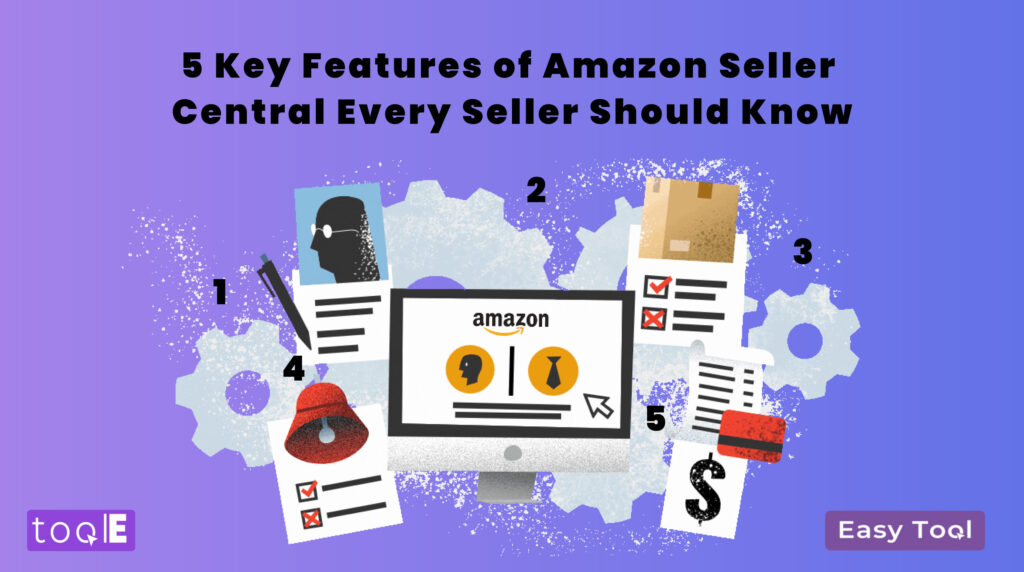Amazon Easy Tool: Revolutionizing Shopify-Amazon Integration for Global Success

The e-commerce landscape is evolving faster than ever, and businesses that fail to adapt risk being left behind. As more consumers turn to platforms like Amazon for their shopping needs, having an efficient Shopify-Amazon integration solution becomes essential. By choosing Amazon Easy Tool, you not only gain access to cutting-edge features but also a partner committed to helping your business thrive in a highly competitive environment.
Expanding Your Amazon Business Internationally: Unlocking Global Growth Opportunities

Expanding Your Amazon Business Internationally: Unlocking Global Growth Opportunities Navigating Amazon’s Seller Performance Metrics and Policies Unlock Scalable Success with Easy Tool for Shopify Plus Merchants Staying Ahead of the Competition: Advanced Techniques for Sellers on Amazon Seller Central Simplify Your E-commerce Operations by Easily Syncing Your Amazon Custom Products to Shopify with Amazon Easy Tool 5 Key Features of Amazon Seller Central Every Seller Should Know Sailing Smoothly Beyond the Holidays: Tailored eCommerce Strategies for Shopify and Amazon Sellers How to connect your Shopify account to Amazon in 3 steps What is an Amazon seller Central SKU? Harnessing Synergy: The Advantageous Fusion of Shopify and Amazon for Merchants Expanding Your Amazon Business Internationally: Unlocking Global Growth Opportunities 17 July 2024 • 5 minute read In the dynamic world of e-commerce, Amazon has emerged as a global powerhouse, providing sellers with access to a vast customer base across multiple continents. As a savvy Amazon seller, expanding your business into international markets can unlock a world of growth opportunities, but it also comes with its own set of challenges. In this blog, we’ll explore the benefits and considerations of selling on Amazon’s global marketplaces, share insights on selecting the right international markets, and provide a step-by-step guide to setting up an Amazon account in new regions. The Benefits of Selling Internationally on Amazon Tapping into New Customer Bases: By expanding your presence on Amazon’s global platforms, you gain access to a diverse customer base, each with unique preferences and purchasing patterns. This diversification can help mitigate the risks associated with relying on a single market and open up new avenues for sales growth. Increased Revenue Potential: With a larger customer pool to engage, the potential for increased revenue and profitability is significant. International expansion can unlock new opportunities for your products, allowing you to capitalize on untapped demand. Seasonality Advantages: Different regions often have distinct seasonal patterns, which can help you balance your sales throughout the year. When one market may be experiencing a slower period, another could be in the midst of a sales peak, evening out your revenue streams. Competitive Edge: By establishing a presence in multiple Amazon marketplaces, you gain a competitive advantage over sellers who are limited to a single region. This can help you stay ahead of the curve and solidify your position as a trusted global brand. Selecting the Right International Markets Choosing the appropriate international markets to expand into is crucial for the success of your Amazon business. Consider the following factors when evaluating potential markets: Market Size and Growth Potential: Research the size of the e-commerce market in the target region and its projected growth trajectory. This can help you assess the long-term viability and scalability of your venture. Demand for Your Products: Analyze consumer preferences and buying patterns in the target market to ensure there is a demand for your products. Utilize Amazon’s sales data and market research tools to gauge the fit. Regulatory and Tax Considerations: Familiarize yourself with the legal and tax requirements for selling in the new market. This may include understanding customs regulations, product certifications, and applicable taxes. Logistics and Infrastructure: Evaluate the logistics and shipping capabilities within the target market, as well as the overall infrastructure for efficient order fulfillment and customer service. By carefully considering these factors, you can identify the most promising international markets that align with your products, business goals, and resources. Challenges of Selling on Amazon’s Global Marketplaces While the benefits of international expansion are undeniable, it’s essential to be aware of the challenges that come with selling on Amazon’s global platforms: Language and Cultural Differences: Adapting your product listings, marketing materials, and customer service to the local language and cultural nuances can be a significant hurdle. Effective localization is key to connecting with your new customer base. Regulatory Compliance: Each country has its own set of rules and regulations governing e-commerce, product safety, and taxation. Navigating these complexities can be time-consuming and requires in-depth research and coordination. Logistical Complexities: Ensuring efficient order fulfillment, managing inventory, and providing reliable shipping and returns across international borders can pose logistical challenges. Partnering with local logistics providers or utilizing Amazon’s fulfillment services can help mitigate these issues. Increased Competition: As you enter new markets, you may face increased competition from local and global sellers. Staying agile, adapting your strategies, and leveraging your unique selling points will be crucial to standing out in the crowd. Step-by-Step Guide to Setting Up an Amazon Account in New Regions Research and Select the Target Market(s): Conduct thorough market analysis to identify the most promising regions for your products and business model. Consider factors such as market size, growth potential, demand for your products, and regulatory environment. Register for an Amazon Seller Account: Follow the specific registration process for the target Amazon marketplace, ensuring compliance with all requirements. This may involve providing business documentation, tax information, and other necessary details. Localize Your Product Listings: Translate product descriptions, titles, and other relevant information into the local language(s) to cater to your new customer base. Adapt your imagery, pricing, and shipping options to match local preferences and expectations. Optimize for Local Search: Familiarize yourself with the search algorithms and keywords relevant to the target market to ensure your products are easily discoverable. Utilize Amazon’s tools and resources to research and implement effective SEO strategies. Adapt Your Pricing and Shipping Strategies: Consider factors such as currency exchange rates, local competition, and shipping costs to price your products competitively in the new market. Offer flexible and affordable shipping options to meet customer expectations. Provide Exceptional Customer Service: Offer localized customer support, easy returns, and responsive communication to build trust and customer loyalty in the new market. Leverage Amazon’s customer service tools and resources to deliver a seamless experience. Monitor and Analyze Performance: Continuously track your sales, customer feedback, and market trends in the new region. Use this
Navigating Amazon’s Seller Performance Metrics and Policies

Navigating Amazon’s Seller Performance Metrics and Policies Unlock Scalable Success with Easy Tool for Shopify Plus Merchants Staying Ahead of the Competition: Advanced Techniques for Sellers on Amazon Seller Central Simplify Your E-commerce Operations by Easily Syncing Your Amazon Custom Products to Shopify with Amazon Easy Tool 5 Key Features of Amazon Seller Central Every Seller Should Know Sailing Smoothly Beyond the Holidays: Tailored eCommerce Strategies for Shopify and Amazon Sellers How to connect your Shopify account to Amazon in 3 steps What is an Amazon seller Central SKU? Harnessing Synergy: The Advantageous Fusion of Shopify and Amazon for Merchants Deciding Between Shopify and Amazon: A Journey Filled with Insights and Learnings Navigating Amazon’s Seller Performance Metrics and Policies 15 July 2024 • 5 minute read As an Amazon seller, maintaining a healthy seller account and avoiding policy violations is crucial for your long-term success on the platform. Amazon’s seller performance metrics and policies can be complex and nuanced, but understanding them is essential to keep your business thriving. In this blog post, we’ll explore key seller metrics, offer guidance on maintaining a healthy seller account, and suggest ways to address and resolve any seller performance issues. Key Amazon Seller Performance Metrics Order Defect Rate (ODR): This metric measures the percentage of orders that result in a negative customer experience, such as an A-to-z Guarantee claim, a chargeback, or a customer feedback rating of 3 stars or less. Amazon expects sellers to maintain an ODR of less than 1%. Cancellation Rate: This is the percentage of orders you’ve had to cancel. Amazon wants to see a cancellation rate below 2.5%. Frequent cancellations can hurt the customer experience and your seller standing. Late Shipment Rate: This is the percentage of orders you’ve shipped after the expected delivery date. Aim to keep this rate below 4% to meet Amazon’s performance targets. Pre-Fulfillment Cancel Rate: This is the percentage of orders you’ve cancelled before shipping. Amazon wants to see this rate below 2.5%. Customer Response Time: Amazon expects you to respond to customer messages within 24 hours. Maintaining a quick response time helps ensure a positive customer experience. Maintaining a Healthy Seller Account Deliver on Your Promises: Ensure you can fulfill orders accurately and on time. Overselling, inventory management issues, and logistical challenges can all negatively impact your seller performance. Provide Excellent Customer Service: Respond promptly to customer inquiries, address concerns quickly, and go the extra mile to keep customers satisfied. Positive customer feedback is crucial for your seller standing. Monitor Your Metrics: Regularly review your seller performance metrics and address any issues before they escalate. Amazon provides detailed performance reports to help you track your progress. Proactively Resolve Problems: If you encounter a problem, such as a high cancellation rate or late shipments, take immediate action to address the root cause and prevent it from happening again. Stay Up-to-Date on Policies: Amazon’s seller policies are subject to change, so it’s important to stay informed about any updates that may impact your business. Review the policies regularly and make adjustments as needed. Addressing and Resolving Seller Performance Issues Understand the Root Cause: If you receive a performance warning or notification from Amazon, take the time to understand the underlying issue. Is it a logistical challenge, a customer service problem, or something else? Develop a Corrective Action Plan: Once you’ve identified the root cause, create a detailed plan to address the problem. This may involve improving your inventory management, updating your shipping processes, or enhancing your customer service. Communicate with Amazon: If you’re unable to resolve the issue on your own, reach out to Amazon’s seller support team. Be prepared to provide evidence of the steps you’ve taken to address the problem and your plan for improvement. Automate Processes: Consider implementing tools and systems to streamline your operations and reduce the risk of performance-related issues. For example, use inventory management software to track your stock levels and set reorder points. Continuous Improvement: Regularly review your seller performance metrics and make adjustments as needed. Identify areas for improvement and implement changes to enhance the customer experience and maintain a healthy seller account. By understanding Amazon’s seller performance metrics and policies, and taking proactive steps to address any issues, you can position your business for long-term success on the platform. Remember, maintaining a healthy seller account is not just about meeting Amazon’s requirements – it’s also about providing an exceptional experience for your customers. By prioritizing customer satisfaction, you’ll not only improve your seller performance but also build a loyal customer base that can drive the growth of your Amazon business. More than 2 results are available in the PRO version (This notice is only visible to admin users) Free Sync to Amazon today We have a range of plans available suited to your needs. The free plan allows 25 SKUs inventory Sync and up to 20 Orders/month. See Plans Navigating Amazon’s Seller Performance Metrics and Policies Navigating Amazon’s Seller Performance Metrics and Policies 15 July 2024 Navigating Amazon’s Seller Performance Metrics and Policies Unlock Scalable Success… Read More Unlock Scalable Success with Easy Tool for Shopify Plus Merchants Unlock Scalable Success with Easy Tool for Shopify Plus Merchants 31 May 2024 Unlock Scalable Success with Easy Tool for Shopify Plus Merchants Staying Ahead of the Competition:… Read More Staying Ahead of the Competition: Advanced Techniques for Sellers on Amazon Seller Central Staying Ahead of the Competition: Advanced Techniques for Sellers on Amazon Seller Central 15 May 2024 In the fiercely competitive landscape of e-commerce, Amazon reigns supreme as the ultimate marketplace… Read More Simplify Your E-commerce Operations by Easily Syncing Your Amazon Custom Products to Shopify with Amazon Easy Tool Simplify Your E-commerce Operations by Easily Syncing Your Amazon Custom Products to Shopify with Amazon Easy Tool 22 February 2024 In the competitive world of e-commerce, offering customizable products can be a game-changer for businesses… Read More 5 Key Features of Amazon Seller Central Every
Unlock Scalable Success with Easy Tool for Shopify Plus Merchants
Unlock Scalable Success with Easy Tool for Shopify Plus Merchants Staying Ahead of the Competition: Advanced Techniques for Sellers on Amazon Seller Central Simplify Your E-commerce Operations by Easily Syncing Your Amazon Custom Products to Shopify with Amazon Easy Tool 5 Key Features of Amazon Seller Central Every Seller Should Know Sailing Smoothly Beyond the Holidays: Tailored eCommerce Strategies for Shopify and Amazon Sellers How to connect your Shopify account to Amazon in 3 steps What is an Amazon seller Central SKU? Harnessing Synergy: The Advantageous Fusion of Shopify and Amazon for Merchants Deciding Between Shopify and Amazon: A Journey Filled with Insights and Learnings Maximizing Your Sales Potential on Amazon in 2024: 5 Proven tactics for effective selling. Unlock Scalable Success with Easy Tool for Shopify Plus Merchants 31 May 2024 • 5 minute read As an eCommerce business owner, you understand the importance of efficiently managing your sales channels and inventory across multiple platforms. For Shopify Plus merchants, integrating your Shopify store with Amazon’s vast marketplace can unlock unprecedented growth opportunities. Enter Amazon Easy Tool, a powerful solution that simplifies the process of synchronizing your Shopify and Amazon operations, empowering you to scale your business The Shopify Plus Advantage: Shopify Plus is the enterprise-level platform designed to support high-volume, high-growth businesses. With its robust features, and scalable infrastructure, Shopify Plus provides the foundation for eCommerce success. Shopify Plus offers a range of benefits that make it a preferred choice for growing eCommerce businesses: Scalability: As your business expands, Shopify Plus can effortlessly handle increased traffic, transactions, and product listings without compromising performance. Customization: The platform’s flexible architecture allows for extensive customization, enabling you to create a unique, branded shopping experience for your customers. Enterprise-grade features: Shopify Plus is equipped with advanced features, including multi-channel integration, wholesale capabilities, and powerful analytics tools, to streamline your operations. Reliability and security: Shopify Plus is built on a robust and secure infrastructure, ensuring the protection of your sensitive data and providing a reliable platform for your online store. However, to truly maximize your Shopify Plus store’s potential, seamless integration with other sales channels, such as Amazon, is crucial. Introducing Amazon Easy Tool: Amazon Easy Tool is the missing link between your Shopify Plus store and the Amazon Marketplace. This powerful integration tool enables you to streamline your inventory management, order fulfillment, and customer data synchronization, all from within your Shopify back-office. Why Easy Tool is Perfect for Shopify Plus Merchants: Seamless Integration Adopting new tools can be daunting, particularly when it requires integrating them into existing systems without disrupting ongoing operations. Easy Tool stands out by offering seamless integration with Shopify Plus. This hassle-free integration ensures that your business processes continue uninterrupted, allowing you to quickly benefit from Easy Tool’s capabilities without extensive technical adjustments. The integration supports various functionalities of Shopify Plus, making the transition smooth and ensuring that all aspects of your store management are unified under one comprehensive tool. Enhanced Inventory Synchronization & Management Managing a large inventory can be daunting, but Amazon Easy Tool simplifies this process with its robust inventory management system. Whether you’re selling through Fulfillment by Amazon (FBA), Fulfillment by Merchant (FBM), or a combination of both, the tool ensures that your stock levels are accurately reflected across both platforms.Easy Tool’s inventory management features include: Automatic synchronization of product listings and stock levels between Shopify and Amazon Ability to manage inventory for both FBA and FBM products from a single dashboard Customizable inventory rules to ensure optimal stock levels and prevent stockouts These features ensure you can maintain optimal stock levels, avoid overstocking or stockouts, and meet customer demand consistently. The result is a more efficient supply chain and improved customer satisfaction. Seamless Order Processing: Amazon Easy Tool seamlessly imports all your Amazon orders, including Prime, FBA, and FBM, directly into your Shopify back-office. With just a few clicks, you can efficiently process orders, manage fulfillment, offer refunds, and maintain excellent seller metrics on the Amazon Marketplace. The order management capabilities of Amazon Easy Tool include: Automatic order import from Amazon to Shopify Streamlined order processing and fulfillment within the Shopify platform Seamless management of returns and refunds Scalability Scalability is at the core of Easy Tool’s design. As your business grows, Easy Tool scales with you. It handles increased traffic, larger order volumes, and more complex operations without compromising performance. This makes it an ideal solution for Shopify Plus merchants who need a reliable tool that grows alongside their business. Enhanced Customer Experience: By consolidating your customer data between Shopify and Amazon, Amazon Easy Tool empowers you to provide a seamless purchasing experience for your customers. This integration ensures that your customers’ details are readily available, enabling you to ship orders promptly and maintain high levels of customer satisfaction. The customer-centric features of Amazon Easy Tool include: Synchronized customer information between Shopify and Amazon Improved order tracking and communication for your customers Enhanced post-purchase support and follow-up opportunities Real-World Example: Zero Foxtrot To illustrate the real-world benefits of Amazon Easy Tool, take a look at Zero Foxtrot, a leading military lifestyle apparel brand. Zero Foxtrot, a Shopify Plus merchant, recognized the immense potential of the Amazon Marketplace to reach a wider customer base and drive their eCommerce growth. By leveraging Amazon Easy Tool, they were able to Increase their overall sales and improve their Amazon seller metrics, strengthening their position on the highly competitive marketplace The success of Zero Foxtrot’s integration with Amazon Easy Tool is a testament to the power of streamlining eCommerce operations and how the right tool can unlock new growth opportunities for Shopify Plus merchants. Conclusion For Shopify Plus merchants seeking to unlock scalable success, Easy Tool is an invaluable asset. Its seamless integration, enhanced inventory management, automation capabilities, advanced analytics, scalability, and customizable features make it the perfect solution to support and accelerate your growth journey. Unlock the full potential of your Shopify Plus store with Amazon Easy Tool and watch your business scale new heights effortlessly.
Staying Ahead of the Competition: Advanced Techniques for Sellers on Amazon Seller Central

In the fiercely competitive landscape of e-commerce, Amazon reigns supreme as the ultimate marketplace for sellers. With millions of products and countless sellers vying for attention, standing out and staying ahead of the competition is no easy feat. To thrive on Amazon, sellers must continually refine their strategies and leverage advanced techniques to maintain a competitive edge. In this comprehensive guide, we’ll delve into some advanced tactics that sellers can employ on Amazon Seller Central to stay ahead of the game.
Simplify Your E-commerce Operations by Easily Syncing Your Amazon Custom Products to Shopify with Amazon Easy Tool

In the competitive world of e-commerce, offering customizable products can be a game-changer for businesses looking to provide unique and personalized experiences to their customers.
Amazon, one of the largest online marketplaces, recognizes the importance of customization and has introduced a feature called Amazon Custom. This feature allows sellers to offer customizable products to their customers. However, managing and synchronizing these custom products across multiple platforms can be a daunting task. That’s where Amazon Easy Tool comes in. Amazon Easy Tool provides a seamless solution to sync Amazon’s customizable products to Shopify, streamlining your e-commerce operations. Let’s explore how this integration can benefit your business.
5 Key Features of Amazon Seller Central Every Seller Should Know

Amazon Seller Central is a powerful platform that empowers sellers to efficiently manage their Amazon business. Whether you’re a new seller or an experienced one, understanding the key features of Amazon Seller Central is crucial for achieving success. In this blog post, we will explore five key features that every seller should know.
Sailing Smoothly Beyond the Holidays: Tailored eCommerce Strategies for Shopify and Amazon Sellers

As the festive lights dim and the decorations come down, eCommerce sellers on platforms like Shopify and Amazon face the challenge of keeping the sales momentum alive. It’s a familiar tale: the post-holiday slump hits, and consumer spending tightens. But with the right approach, this period can be a time of strategic growth and opportunity.
How to connect your Shopify account to Amazon in 3 steps

Running an online business can be challenging, especially when it comes to managing stock and orders across multiple platforms. However, with the Shopify Amazon Integration offered by Amazon Easy Tool, you can simplify your operations and save valuable time and energy. Keep reading to explore how integrating your stock and orders in one interface can revolutionize your business.
What is an Amazon seller Central SKU?

Businesses often gravitate towards Amazon Seller Central as a robust platform for e-commerce and supply chain management. To thrive in this environment, it is crucial to grasp certain fundamental concepts. This guide will explain what a Seller SKU is, its importance, and various identifiers associated with Amazon’s marketplace.

